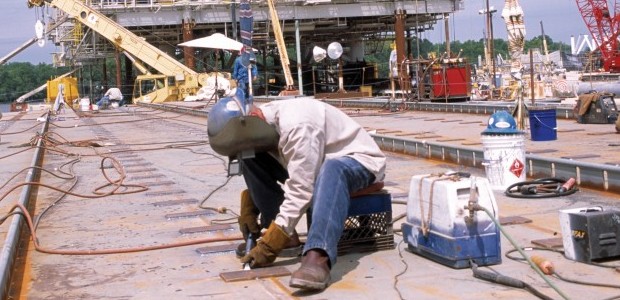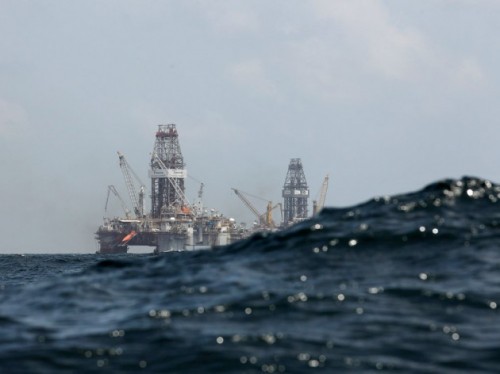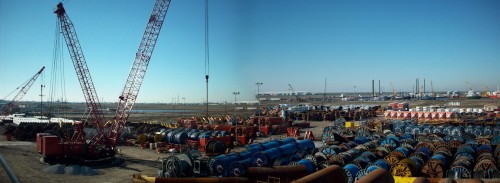
Leader of the Pack: Banker at heart, Chauvin builds Gulf Island
September 25, 2012
Rigs react when weather threatens
September 25, 2012Expansion is the name of the game at Port Fourchon.
“Slip B is completely leased out and tenants are completing work on their sites,” said Chett Chiasson, port director. “Slip C is in the dredge work phase to create the land, and we already have two tenants who have secured space in the slip. The demand on property at the port is high and that is good. Things are going very well.”
The two 7,000 feet long, 700 feet wide additions to the port, both part of the Northern Expansion project, will double the size of the facility, which currently encompasses 1,700 developed acres.
“Slip C will be complete in the next seven or eight years, depending on interest and construction time,” Chiasson said. “Chouest Shore Bay and Guidry Brothers/Harvey Gulf were the first to get space in that slip.
“There is a considerable amount of work being done down here to expand the deepwater oil and gas industry.”
To say the port has bounced back from the April 2010 Deepwater Horizon oil spill and yearlong moratorium on offshore drilling is a huge understatement, the facility’s director said, especially given the size of the Northern Expansion and the fact that tenants inked deals to lease in the immediate wake of the spill.
“We have 130 direct tenants at the port, but several tenants have renters on their sites,” Chiasson said. “About 250 companies do business here on a day-to-day basis. That is a slight bit higher than before the spill. We did not lose one renter during the spill – we actually gained a few.”
With another boon, many current tenants are looking to expand.
In the wake of the BP spill and subsequent drilling moratorium, the port commission agreed to reduce rent by 30 percent to offer economic relief to its clients. Since then, rent has returned to its normal schedule.
“Rent is stable, but we reduced it from July 2010 to June 2011 and froze the escalation rate for one year,” Chiasson said. “We went back to an increase in July 2011.”
Since last July, business has been nonstop. And with Slip B divided into 17 sites and sites at Slip C already going, Chiasson is optimistic about the continued business growth in the area.
“Deepwater is sparking all this quick expansion,” Chiasson said. “There is less shallow-water work, mostly plug-and-abandonment jobs, and the drilling aspect is very low, but deepwater is picking up.”
With deepwater work increasing, Chiasson said there will also be a jump in construction of deepwater supply vessels used to service the industry.
“When you bring up the spill and that year of uncertainty, we are doing much better now than we were then,” he said. “We are a year behind because of the moratorium though, but our outlook for the future has not changed.”
Chiasson credits leadership within the state for the growth and recovery of the oil and gas industry in south Louisiana.
“The Gulf Economic Recovery team and Scott Angelle, the secretary of the state’s Department of Natural Resources, worked hard to get permit issues resolved after the spill,” Chiasson said. “They turned things around and they worked hard to get it done. The uncertainty put us in a bad situation but it could have been worse. We have good leadership in this state and we worked together to move forward.”
Delmar Systems and Mac-Nett Environmental, two companies operating at the port prior to the 2010 spill and moratorium, report their business is almost back to pre-oil spill levels.
“We are busy and I think that we will continue to be busy,” said Brady Como, executive vice president of Delmar Systems. “Oil, natural gas and fossil fuels will be important for years to come. Look at all the items on your desk when you are at work and think about how they were made.”
The company’s 11-acre tract at the port is outfitted with heavy lifting cranes, a necessity in Delmar’s line of work, providing offshore anchor handling and mooring services. The 44-year-old company, based in Lafayette, has been a renter at Port Fourchon for 25 years.
“We were located in the old section, but we moved to the new section,” Como said. “We have one of the largest tracts at the port – 600 feet of bulkhead. We pay the going rate for rent and are in a long-term lease with the port.”
The company’s Port Fourchon yard is open 24/7 and has a full-time staff of 12 local workers.
“We service moored rigs, which are anchored and connected to the ocean floor by wires, and dynamic positioning satellite rigs,” Como said. “We currently have 30 DP (dynamically-positioned) rigs and six moored rigs. Before the moratorium, we had 15 moored rigs but, after the spill, these rigs were moved from the Gulf to places like Brazil and West Africa.”
While the company continues to service DP rigs, which are held in place by hydro-acoustics, Como said the move-out of moored rigs has taken its toll on several other oil- and gas-related industries.
“It’s like following a circus – pack up, leave and follow the rigs,” Como said. “Anchor boats, engineers and planning operators who conduct full-mooring analyses with wave, wind, weather and current readings have to follow the work to other locations. When the government handed down the moratorium, we were out there picking up these rigs so that they could be moved.”
With many moored rigs now scattered around the globe, rig operators are also feeling the chain reaction of the drilling moratorium.
“It’s hard for operators to find equipment because there is a shortage of moored rigs,” Como said. “They have permits but no equipment and have to wait for a rig to come back. Not everyone can afford a $600 to $700 million drill ship. The moratorium really hurt. It took the capacity outside the Gulf.
“This industry is not set up to stop working. When a plane blows up, the government doesn’t ground all flights,” he continued. “We have one major mistake and they think that the Louisiana oil industry is unsafe. We were painted with a pretty broad brush.”
Like many in south Louisiana, Como is hopeful attitudes toward the industry will improve in time.
“We will be busy as our country’s demand for us to be energy independent from countries that are not friendly to us continues,” Como said. “We have a bright future and we have and will continue to work safer. The port has a bright future as well. The port has a wonderful capacity and capability and is ready for world-class development.”
Mac-Nett Environmental manager Troy Tucker is also optimistic about his company’s future at Port Fourchon.
“We’re not quite back to where we were before the oil spill but we’re about three-fourths of the way there,” he said.
One of the smaller companies at the port, Tucker said his company rents a 300-by-300 foot space. The company provides tank truck vessels and crew boat cleaning – servicing about 10 vessels weekly – and has been renting from the port for the past 15 years.
“We employ 24 people from Fourchon and we work 24/7,” the manager said.
“There are no changes in the plans for the company,” Tucker said. “The boss is happy and content, and five years out, we still plan to be a renter at Port Fourchon.”
A suction anchor is loaded at Delmar Systems’ yard in Port Fourchon. The company provides offshore anchor handling and mooring services. Currently, Port Fourchon covers more than 1,700 developed acres. When Slip B and Slip C, part of the Northern Expansion project, are completed, the size of the port will be doubled.










